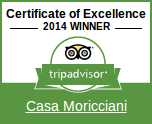"Panzanella" di Zia Flora (my husband's aunt)
 "Panzanella" is a Tuscan rustic poor bread salad, perfect in the summertime, and it has its origin in the old farmer's traditions. It's a very simple and easy–to–make dish that doesn't require any cooking and because of that, in the past, was eaten on the fields where no heating was possible. Panzanella, a glass of wine...and back to work!
"Panzanella" is a Tuscan rustic poor bread salad, perfect in the summertime, and it has its origin in the old farmer's traditions. It's a very simple and easy–to–make dish that doesn't require any cooking and because of that, in the past, was eaten on the fields where no heating was possible. Panzanella, a glass of wine...and back to work!
Ingredients (for 4 people):
500 g (1 lb) of one–day–old bread
15 leaves of fresh basil
1 fresh cucumber
1 red onion
2 ripe tomatoes
Fresh lettuce
Salt
Freshly ground black pepper
Extra virgin olive oil
Preparation:
Remove the crust of the bread (and feed it to the birds). Soak the bread in room–temperature water for about 30 seconds until it becomes soft, but not completely wet. Remove it from the water and squeeze it firmly between your fingers, removing as much of the water from the bread as possible. Make rough bread crumbs out of it by rubbing the bread between your hands, letting the crumbs fall into a large mixing bowl.
Add to the bread crumbs the peeled and thinly sliced onion, finely diced tomatoes, peeled and cubed cucumber, thinly sliced lettuce, and shredded basil leaves (tearing with your fingers, not by cutting it with a knife).
Add salt, pepper, and a good amount of a good quality, extra virgin olive oil and stir well. Put in the refrigerator for 1 hour. Before serving add more olive oil.
Tip:
The authentic original recipe is very simple. You can add chopped boiled eggs, yellow and red bell peppers, anchovies, tuna, celery, and some people like to add red wine vinegar. It won't be typically Tuscan any longer but still delicious!!
Elide's "Chickpea Soup" (my very best friend in Castelmuzio)
 Chickpea (garbanzo beans) soup is simply delicious. It is easy to prepare, and it meets everyone's taste. It was a very popular dish because the high protein content of the chickpeas compensated for the lack of meat in poor times.
Chickpea (garbanzo beans) soup is simply delicious. It is easy to prepare, and it meets everyone's taste. It was a very popular dish because the high protein content of the chickpeas compensated for the lack of meat in poor times.
Ingredients (for 4 people):
2 cans of cooked chickpeas, rinsed and drained (if you have time dry ones are better!)
1 large white onion (or 2 medium ones), sliced
2 garlic cloves, peeled and minced
350 ml (12 oz) of homemade broth (see recipe below)
1 tablespoon of tomato paste
Salt
Fresh rosemary sprigs for garnish
Freshly ground black pepper
Extra virgin olive oil
Preparation:
Heat the olive oil in a deep pot over medium heat together with the sliced onion and the minced garlic, and cook for about 10 minutes, stirring frequently. Stir in the broth and about three–quarters of the chickpeas, and bring to a boil. Reduce heat, and simmer 15 minutes.
Use the blender (a wand hand mixer is perfect for this!) and process until it becomes creamy with a fairly dense consistency. Add back the remainder of the chickpeas and heat again.
Season with salt . Serve and sprinkle with olive oil, abundant black pepper (to taste, of course!), and garnish each person's serving with rosemary sprigs.
Tip:
For a better tasting soup, start with dried chickpeas. Put 350 g (12 oz) of dry chickpeas in a bowl, cover them entirely with cold water, and soak for about 48 hours, then drain them and cook them in about 2 liters (8.5 C) of water with some salt for 2.5 hours. Then, drain them and use them as described above.
Isa's "Risotto alla Milanese"
 "The Risotto alla Milanese" is a typical dish of the Milanese cooking tradition. It dates back to 1574 when a glass artisan named Zafferano added some saffron that he used for coloring his paints to his risotto for his daughter's wedding. Saffron comes from the tiny purple crocus flowers that produce three stigmas per flower that are hand picked and dried. It takes 14,000 of these delicate stigmas to produce one ounce of saffron! It is best to use the dried pistils...but if you can't find them... a good (and not expensive!) substitute is the saffron powder.
"The Risotto alla Milanese" is a typical dish of the Milanese cooking tradition. It dates back to 1574 when a glass artisan named Zafferano added some saffron that he used for coloring his paints to his risotto for his daughter's wedding. Saffron comes from the tiny purple crocus flowers that produce three stigmas per flower that are hand picked and dried. It takes 14,000 of these delicate stigmas to produce one ounce of saffron! It is best to use the dried pistils...but if you can't find them... a good (and not expensive!) substitute is the saffron powder.
Arborio rice comes from Italy. Its short, fat grains have a hard starchy center and a soft starchy shell. So it makes sense that, when cooked, the soft shell produces creaminess while the center remains crunchy.
The best arborio rice is a premium Carnaroli rice imported from Italy. It's hard to find but worth the search!
Ingredients (for 4 people):
400 g (14 oz) arborio rice, Carnaroli or Vialone Nano
60 g (2 oz) butter
50 g (1.7 oz) beef marrow (get this from your butcher), minced
1 small white onion, thinly sliced
¾ glass of white, dry, non sparkling wine (must be warmed up)
0.5 g (0.01 oz) of saffron pistils or 2 packets of saffron powder
80 g (3 oz) grated Parmesan cheese
1.5 liter (6.5 cups) good meat broth, boiling hot (use my broth recipe below!)
Salt to taste
Preparation:
In a casserole, simmer the finely sliced onion and the beef marrow in half the butter over low flame for about 10 minutes; the onion should become translucent but not brown. Add the rice and sauté the rice over a moderate flame for 7-8 minutes, stirring constantly and let it lightly toast.
Stir in the warmed wine and cook, stirring, until it has completely evaporated. Then stir in one ladle of the hot broth, and once most of it has been absorbed add another, stirring until it absorbed. Continue in this fashion, adding liquid until the rice is almost at the al dente stage. It is very important not to add the broth all together, but stirring constantly, adding one ladle at the time in order to release the rice's starch.
When you get to half of the cooking, stir in the saffron (previously diluted in one ladle of warm broth), add salt if needed, and finish the cooking (altogether it will take 18–20 minutes), then turn off the heat. Add the remaining butter, and the Parmesan cheese. Stir for about 20 seconds, cover and let sit for a couple of minutes before serving.
You can serve it either as a bed for Ossobuco alla Milanese (see recipe below) or as a first course, with more Parmesan cheese on the side.
Tip:
If you serve Risotto as a first dish you can add ultra thin gold leaves on top, it makes a precious and raffinata presentation!
Pici "Moricciani Style"
 Pici is the local pasta made only in the Val d'Orcia. Every woman has her own way of making the dough--there are as many ways to combine ingredients (with eggs, without eggs, etc.) as there are cooks! This is why we call this recipe "Moricciani Style" because it is the way we make it. We like our pici with Liliana's "Ragù" (the recipe is available in the "Broth and Sauces" section).
Pici is the local pasta made only in the Val d'Orcia. Every woman has her own way of making the dough--there are as many ways to combine ingredients (with eggs, without eggs, etc.) as there are cooks! This is why we call this recipe "Moricciani Style" because it is the way we make it. We like our pici with Liliana's "Ragù" (the recipe is available in the "Broth and Sauces" section).
Ingredients (for 2-3 persons):
1 kg unbleached all-purpose flour*
1 whole egg
1 glass of water (ca. 200 ml) at room temperature
1 cup all purpose flour (to keep the pici separated while they are drying)
If you have taken the pici-making class at Cretaiole, you know that it is important to adjust the water according to the way the dough feels. The size of the eggs, the amount of humidity in the air, etc., will make it necessary for you to use more or less water to make the dough right. So, please take these measurements as approximate amounts.
*See tip below for gluten-free flour
Preparation:
Pour 1 kg flour on a wood or rough marble counter and form a well in the center. Add the egg to the center of the well and beat with a fork. Add the water and mix with the fork while not letting the water escape; when the ingredients come together start using your hand to mix them until the dough forms. Work together until smooth and homogeneous. Knead dough for 5-10 minutes, adding a little more flour if necessary to prevent sticking.
The dough at the end of the work must be quite solid, but elastic, not sticky. Note: if it is still too sticky add some more flour, if it is too hard you can’t add more water!
Brush top of dough with some olive oil to prevent skin from forming, and cover with a cloth. Let rest for 10 minutes.
How to “roll” the “pici”:
To make “Pici” is an art, but with some training you’ll be able to get good results. The “picio” must have the shape of an irregular “spaghetto”, but it must be thicker than regular spaghetti. A “picio” can be up to 2 meters long!
It is preferable to work on a rough surface (or even a silicon pastry mat--they work great!) which has to be completely clean and with no flour! Put also a drop of olive oil in the palm of your hands before starting, it will be easier for you to roll the pici.
First roll the dough out on a lightly floured counter until it is 1/16” thick. Cut into 1/8” wide pieces. The left hand must keep the left end of the piece while the right hand is rolling. Always roll the pici under the palm, not under the fingers! The right hand must move on the picio from the right to the left.
When the picio is done, hang in loops over your hand and put it into the flour to prevent them from sticking and place on prepared baking sheets or platters. Repeat with remaining dough.
Bring a large pot of water to a boil; add a handful of salt. Cook pasta until al dente, about 5 minutes. Drain.
Tip:
If you need a gluten-free pasta, use this same recipe but try it with Jules Gluten Free Flour (www.julesglutenfree.com). This tip comes from one of our guests from the United States. She simply substituted the flour with this particular gluten-free flour. Other brands may work as well. Try it and let me know about the results!
THE EXPERIENCE
OUR OTHER PROPERTIES
FOOD & HEALTH

Casa Moricciani
di Isabella Barlocher
Via Gaetano Milanesi, 13
53020 Castelmuzio (Siena)
Tel./Fax (+39) 0578. 748083
Cell (+39) 338. 7409245
(Isabella-English/German)
Cell (+39) 339. 6640060
(Carlo-Italian/French)
Email: info@casamoricciani.com
P. IVA 01299880524








